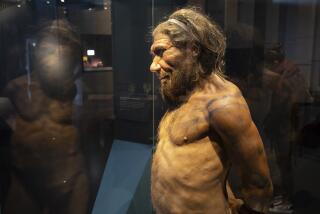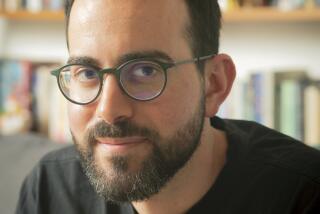Corrupting the Classics : THE SECRET HISTORY, <i> By Donna Tartt (Alfred A. Knopf: $23; 524 pp.)</i>
Comes now, beating its own drum, Alfred A. Knopf’s production of “The Secret History.” A first novel by a young writer who has worked on it for eight years, it is both unripe and wizened. Early promotional heat-treatments have done nothing to remedy the first condition, and they almost seem to have advanced the second.
Set in a small and stylish New England college, “Secret History” is about a half-dozen students who constitute a group so exclusive, so intellectually refined, so decadent, and ultimately so deadly, that they make the rest of the college seem like Podunk Tech.
Their mentor and guru is Julian, a classics professor who teaches all their courses, mainly Greek and Latin, and who stands for pagan pantheism and the hard, gemlike flame. He is supposed to, that is. One of Tartt’s weaknesses is that she is free with attributes and stingy with character, particularly adult character.
Julian virtually sinks from sight after being introduced. And just about all the author can do to suggest his magnetism and allure is to tell us that he was a confidante of Marilyn Monroe, that Osbert Sitwell commended his “sublime little fetes,” that Cyril Connolly found him “gracious” (as believable as Hemingway finding somebody “sweet”), and that George Orwell said he was “superficial and not to be trusted.”
As for Julian’s student adepts, we meet them through Richard, an outsider from a California high school. Improbably, he finds himself accepted as an initiate into their circle. There is Henry, the alternately commanding and unworldly leader, who gets up early in the morning to translate Milton into Latin. There is Francis, foppish, rich and bisexual. There are Charles and Camilla, the mysteriously--not to us savvy readers, though--devoted twins. And there is Bunny, loud, clownish and a leech.
“History” starts off with Bunny dead, having been pushed off a cliff by the others under the direction of Henry; and with Richard telling us how this put an end to the golden times and his illusions. The book’s first half, which shows some narrative skill and a measure of suspense, tells us about the group and why Bunny was killed. The second half, which sags badly, tell us how its members came apart under the pressures of remorse and nervousness.
Wildly melodramatic as many of the incidents are, they could only work if Tartt had succeeded in her design--that is, to suggest the kind of magical if illusory kingdom of the few and the young that Richard, as narrator, is trying to evoke. An example is Alain-Fournier’s “Le Grand Meaulnes” (“The Wanderer”), in which we are drawn into the narrator’s infatuation with the world conjured up by the hero, and his desolation when it ends.
Henry is no Meaulnes, though. Tartt, no Alain-Fournier, is unable to give Richard anything but a ludicrously pretentious and highly uneven voice. At times, the enchanted circle is like Monty Python’s Flying Circus. More nearly, it resembles the comically fraught characters in Edward Gorey’s drawings: Three elongated young men and an elongated young woman, say, all in Edwardian costume, pump a railway handcar on the way to take Aunt Beatrice a plate of fresh-baked nightshade cookies.
The circle goes for country weekends at Francis’ aunt’s mansion. Henry, in a rowboat, discusses Elizabeth and Essex and T. S. Eliot, while the twins sip champagne out of a teapot. Richard is regarded as a curiosity by this ponderously effete circle because he goes to the movies and reads newspapers. When he mentions an astronaut on the moon, Henry is astonished: “ ‘No,’ he said, putting down his fork. ‘How did he get there? When did this happen?’ ”
When Richard learns, or thinks he learns, that the others have suddenly flown off to Buenos Aires, he tells us, Gorey-like: “My God, I thought, what were they doing?” Of a festive afternoon of croquet, he broods: “That laughter haunts me still.”
Bit by bit, he discovers mysteries. One night, the group turns up with strange bruises and cuts; there is a pile of muddy sheets. They have been holding a bacchanal after three days of fasting. Bunny was excluded because he ate a cheese sandwich. A farmer is accidentally killed, Bunny learns about it, there’s a threat of blackmail. And after it is all over, Richard recalls the group’s invariable formal Sunday night dinner, “except on the night of the murder itself when no one felt much like eating, and it was postponed until Monday.”
Often it is hard to believe that Tartt is not, in fact, writing a far-fetched spoof. She is not, though. Richard is deadly serious about himself and his beautiful-and-damned friends, even if he comes to realize at the end that they have destroyed themselves, and that killing people is not only wrong but unhealthy.
Certainly, the writer knows how to tell a story, at least in the first half, while we still want to know what is going on. After the murder, it is all anxious late-night visits--a sure sign that a narrative has run aground--and moral unraveling.
But the unraveling has no interest. You need a character for unraveling. “The Secret History” is like family skits: The cousins go up to the attic, devise extravagant costumes, dole out an extravagant plot. After dinner, they come on and it is great fun seeing who is who and what they are supposed to be. For about 10 minutes. The only thing there is to unravel for the last couple of hundred pages of Tartt’s book is the costumes.
More to Read
Sign up for our Book Club newsletter
Get the latest news, events and more from the Los Angeles Times Book Club, and help us get L.A. reading and talking.
You may occasionally receive promotional content from the Los Angeles Times.






